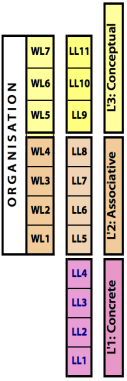Work and Using Language
Original Clues
Organizations exist to do work of a scope and complexity beyond a single individual. So the fundamental driver in designing organizations must be ensuring the effective performance of work by staff. While it is well understood that organizations must have levels and pyramidal charts, clarity about these hierarchies is vague and their operation in practice ranges from inefficient to nightmarish.
The break-through by Jaques and Brown at Glacier Metal Co. in the mid-20th century was to recognize that in organizations:
- levels of management should correspond to defined , and
- line-management authority should be set up to cross just one level.

Jaques observed differences in in his early formulations of . He identified:
- two sharply different by staff at and at .
- progressive and more subtle differences from level to level, which revealed a repetition/correspondence (i.e. to , to &c).
This difference in the came from using information in the lower set of levels and concepts in the higher set as shown in the diagram.
Extending and Generalizing
The originally published work descriptions and management arrangements focused mainly on conventional organizations that produced tangible products or services—like manufacturing, mining, beverages, health services, the military.

At the time of my introduction to Jaques, the knowledge economy was barely born, but its work was remarkably similar to that of academic disciplines. Everyone realizes that both hierarchy and language are rather different in academia.![]() Example
Example
The need for additional formulations became inescapable on entering even more esoteric areas of organisation and management like work in politics (councils, parliaments) and in religions (churches, ashrams).
My starting point was to regard Jaques' 4-level hierarchy within a single as a standard set of styles, a THEE Style Hierarchy. This would then be applicable to all , and not just those types shown in the diagrams here.
It follows that there must be 7 x 4 =28 . I refer to these as starting counting from the lowest style of the . Each of these subsidiary types corresponds to a distinctive way of and therefore there must be .
It is then a separate issue to consider how those enable .
The hierarchy that Jaques and his followers focus on evidently extends from to . By extrapolation, there should be other similar hierarchies, called in THEE: Q-hierarchies. Each of these can be expected to function very differently in accord with the way language is used within them.
As a result, despite many commonalities, each Q-hierarchy will specify work in society in a dramatically different way. The term I use here is "Arena" i.e. the 7 Q-hierarchies specify 7 Arenas of Association requiring Responsible Work.
-
Explore the emergence of Q-hierarchies.
Originally posted: 25-Oct-2013